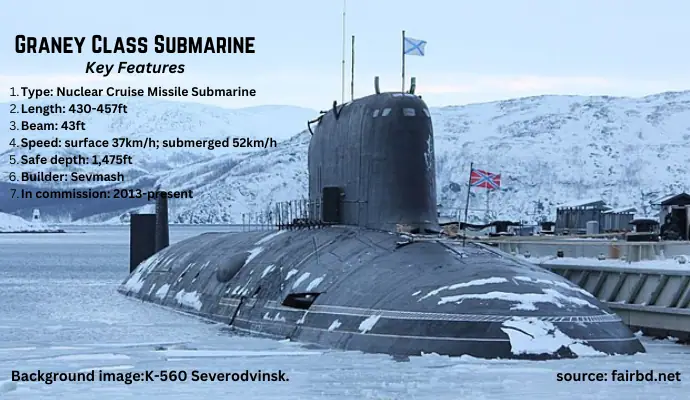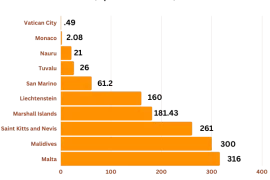The Graney class submarines, officially designated as Project 885 Yasen, are formidable Russian nuclear-powered attack submarines. They represent a significant leap in Russian naval technology. These submarines outshine their predecessor, the Akula class, in terms of capabilities. However, with increased technological prowess came a higher price tag. The Graney class submarines have gradually entered service, marking a lengthy journey from their inception to their operational readiness.
A Long Gestation Period
The journey of the Graney class began when the lead boat, Severodvinsk, was laid down in 1993. Unfortunately, funding issues halted the project in 1996. It was only in 2003 that additional funds breathed new life into the project.

The Severodvinsk was finally delivered to the Russian Navy in 2013 and officially commissioned in 2014. This extended construction period amounted to 21 years, underscoring the challenges faced during development.
A Slow Start and Delays
The second submarine of this class, the Kazan, was laid down in 2009 and launched in 2017. It boasts improvements over the original Yasen class, featuring enhanced electronic systems. Significant design changes were introduced to Kazan, primarily because it was laid down 16 years after the Severodvinsk. Nevertheless, construction hurdles persisted, largely due to financial and technical issues.
Table: Yasen Class Submarines
| Name | Laid down | Launched | Commissioned | Status |
| Severodvinsk (K-329) | 1993 | 2010 | 2014 | In service |
| Kazan (K-561) | 2009 | 2017 | 2021 | In service |
| Novosibirsk (K-573) | 2013 | 2019 | 2021 | In service |
| Krasnoyarsk (K-571) | 2014 | 2021 | Expected in December 2023 | sea trials |
| Arkhangelsk (K-564) | 2015 | 2021 (?) | Expected in 2024 | under construction |
| Perm | 2016 | 2021 | Expected in 2026 [1] | under construction |
| Ulyanovsk | 2017 | ? | Expected in 2026 | under construction |
| Voronezh | 2020 | ? | Expected in 2027 | under construction |
| Vladivostok | 2020 | ? | Expected in 2028 | under construction |
In 2013, the Novosibirsk, another improved Project Yasen-M boat, joined the ranks. In 2020, two more Graney class submarines were initiated, with two additional boats following suit in 2022.
All of these Graney-class submarines are constructed at the Sevmash naval yard in Severodvinsk. It is part of the United Shipbuilding Corporation. Sevmash is currently building 6 Project 88M submarines. St. Petersburg-based Malakhit Marine Engineering Bureau designed the Project 88M submarines.
The Graney class is slated to replace aging Akula class, Sierra I, Sierra II, and Victor III class submarines that are nearing the end of their operational lifespans. With production moving at a relatively slow pace, the Russian Navy may experience a reduction in the number of operational attack submarines in the near future.
Enhanced Capabilities
One notable feature of the Graney class submarines is their larger size compared to the Akula class. Designed to take on carrier battle groups, they are also adept at seeking and neutralizing hostile ballistic missile submarines, attack submarines, and surface ships.
These submarines possess 24 vertical launch tubes for a variety of cruise missiles, including the P-800 Oniks and Kalibr cruise missiles, both of which provide formidable strike capabilities. Additionally, the Graney class submarines are equipped with eight 650 mm torpedo tubes that can carry torpedoes, anti-ship missiles, or mines. Some sources suggest a payload of up to 30 torpedoes and anti-ship missiles, with the option to carry mines. Interestingly, the torpedo tubes are located behind the central station compartment, and there are reports of two 533 mm torpedo tubes as well.
Stealth and Crew
Constructed from low-magnetic steel, the hull of the Graney class submarines incorporates a spherical bow sonar. Despite their efforts, these submarines are only marginally quieter than the improved Akula class and are notably noisier than the U.S. Virginia and Seawolf class nuclear-powered attack submarines.
The crew size of the Graney class submarines varies according to different sources. Some reports suggest a crew of only 50, indicating a high degree of automation. However, others claim that these submarines require a crew of 90 submariners, including 32 officers.
Power and Depth Capability
The heart of the Graney class submarine lies in its single OK-650KPM pressurized water reactor with a power rating of 200 MW. This reactor, an evolved form of the 1970s-era OK-650, is specifically adapted for the Graney class boats. With a service life of 25-30 years and no need for refueling, it delivers power via a steam turbine to a conventional propeller shaft.
The endurance of these submarines is primarily limited by food supplies, and they are reported to be slower than their U.S. counterparts.
Impressively, the Graney class submarines were designed to operate at greater depths than most existing submarines. With the ability to dive to a maximum depth of 600 meters, they surpass many torpedoes’ capabilities. Only the U.S. Seawolf class and Russian Sierra II class attack submarines can reach greater depths, possibly indicating the use of titanium hulls.
A Modified Standard
The submarine Perm deviates slightly from the standard Graney class design. It was modified to carry Tsirkon hypersonic anti-ship and land attack cruise missiles, further enhancing its offensive capabilities. In fact. Perm submarines will be the first regular carrier of Tsirkon missiles.
The submarines Voronezh and Vladivostok, laid down in 2020, will be equipped with improved Kalibr-M cruise missiles boasting a range of 4,500 km, enhancing their long-range strike capabilities.
In conclusion, the Graney class is one of the most powerful attack submarines in the world. With enhanced capabilities and a diverse arsenal, these submarines are set to play a crucial role in Russia’s naval strategy, replacing older vessels and ensuring the nation’s presence and prowess beneath the waves.
Sources
- “Perm Sub with Tsirkon Hypersonic Missiles to Enter Service with Russian Navy in 2026.” Tass, 5 Jan. 2023, https://tass.com/defense/1559017. Accessed October 2, 2023.







